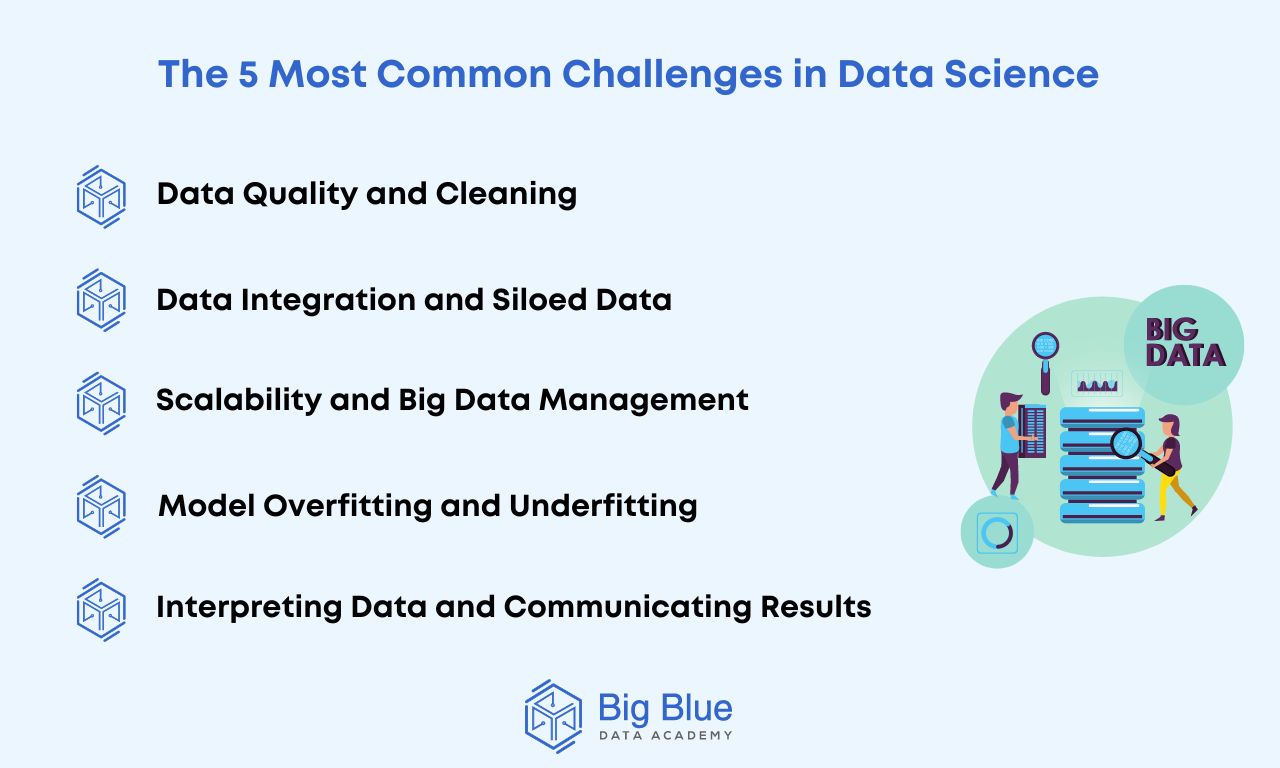5 Common Data Science Challenges and How to Solve Them
Emerging technologies and big data are fundamentally transforming the world of data science, posing new challenges for businesses in their efforts to unfold their full potential.
In today's article, we have gathered 5 common challenges in data science along with their respective solutions.
These challenges are as follows:
- Data quality and cleaning
- Data integration and siloed data
- Scalability and big data management
- Model overfitting and underfitting
- Interpreting data and communicating results
So let's see how these various challenges are solved, starting with the first one on our list.

Challenge #1: Data Quality and Cleaning
Data quality refers to the overall suitability of data to serve its intended purpose.
Good data quality is crucial for organizations to make informed decisions, and understand customers, markets, and operations more effectively.
However, often data may be of poor quality, inaccurate, duplicate, inconsistent, or inappropriate, leading to wrong conclusions, resulting in wrong business decisions, and high costs.
Solution:
To address this challenge and save valuable time and money, it is important to:
- Understand the nature and characteristics of your data.
- Define quality criteria (standards) to detect and eliminate inaccuracies, inconsistencies, and errors in the data.
- Use data cleaning techniques to identify and correct errors and inconsistencies in datasets and remove duplicate or inaccurate records.
- Conduct regular quality checks and proper data governance to ensure data remains accurate, consistent, and usable for various business and analytical purposes.
Challenge #2: Data Integration and Siloed Data
Data silos, where individual units within a company develop separate transaction processing systems without central coordination and data architecture, pose a significant problem for many businesses.
Solution:
To address this issue, organizations use data governance and data integration techniques.
Data integration involves combining and harmonizing data from multiple sources into a unified, coherent format for various analytical, operational, and decision-making purposes.
By eliminating data silos, organizations can eliminate redundancies and inconsistencies resulting from isolated data sources.
Challenge #3: Scalability and Big Data Management
Proper management of big data, characterized by volume, variety, and velocity, is crucial for a business's success in distinguishing itself from the competition.
At the same time, big data scalability, which is the ability of a data architecture to handle increasing volumes, velocities, and varieties of data without compromising performance, reliability, or functionality, is a critical parameter for any data-driven company.
Solution:
To achieve proper management of big data and scalability, it is important to:
- Adopt a scalable infrastructure that is powerful enough to handle data volume and flexible enough to grow with your company.
- Implement policies for proper data governance, ensuring data quality, and establishing a central repository for data storage and access.
- Utilize cloud-based solutions for scalability and flexibility.
Employ Big Data technologies such as Hadoop and Spark frameworks and NoSQL databases for efficient management and analysis of large datasets.
Challenge #4: Model Overfitting and Underfitting
Model overfitting occurs when a machine learning model, trained on a dataset, fits too closely to that dataset, making it unable to generalize to new, unseen data.
On the other hand, underfitting happens when the model fails to identify a meaningful relationship between input and output data.
Underfitted models arise when they have not been trained for the appropriate amount of time on a large number of data points.
Solution:
To address overfitting, it is vital to:
- Stop training at the right time before the ML model memorizes noise in the data.
- Train with more data.
- Apply regularization techniques.
To address underfitting, it is crucial to:
- Use a more complex model.
- Increase the number of features in the dataset.
- Extend the duration of the training time.
Challenge #5: Data Interpretation and Results Presentation
As the field of data science is a highly technical domain, communicating research results from data scientists to managers and stakeholders often poses a challenge.
After all, it is reasonable that stakeholders in a business may not be familiar with tools used by data scientists.
So, how can this challenge be addressed to effortlessly make various critical business decisions?
Solution:
The solution to this challenge lies in adopting a data-driven work culture within the company.
Businesses that focus on creating a data culture empower individuals at every level to understand data and its applications, providing them with the necessary skills to work with it.
For example, in the data science team, a data science manager who guides and carefully trains other data scientists on the data culture can be an excellent choice and investment.
Furthermore, it is crucial to conduct upskilling and reskilling for the company's data scientists to enhance their communication and presentation skills and develop techniques for data storytelling.
This way, business decisions can be effectively communicated, and everyone can understand why a data scientist reached a specific conclusion or proposed a change regarding a company's business product.
Ramping Up
In a nutshell, we’ve thoroughly explored the most common challenges in the field of data science, suggesting some essential solutions.
Skills in the data science field are becoming increasingly vital for the evolution of a business in today's competitive environment.
So, if you are intrigued and want to learn more about AI and data science in general, follow us and we’ll keep you updated with more educational articles!


.jpg)